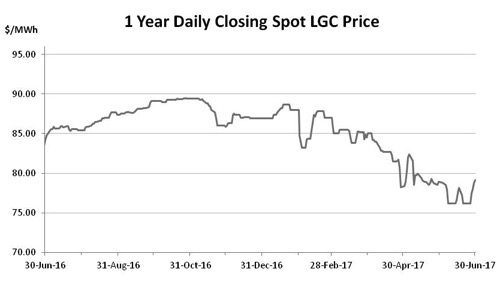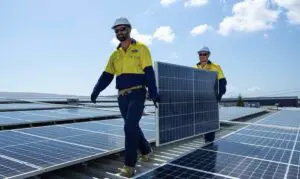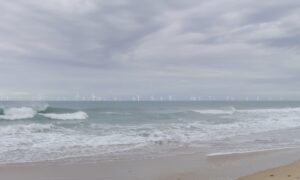
The long awaited release of the Finkel Review – which reflected consensus across the community whilst simultaneously highlighting the divisions within the Turnbull Government– shared the limelight in June with a recovery in the forward market that restored the faith of many pundits. Should the Finkel Review’s recommendations get up, there remain some important questions to be answered for the existing Large-scale Renewable Energy Target.
It ultimately proved a telling month in the LGC market, though interestingly it was forward market activity the led the way.
The spots endured an illiquid and volatile run that ultimately saw the month end close to where it started.
Having opened June in the high $78s the first swing of the pendulum took the market downward, with patchy trade seeing the spot reach a low of $76.15 after a week or so. From there in equally thin volumes the market then rebounded to a high of $78.15 mid month before again softening back to a low of $76.20.
After close to a week without trade the back end of the month brought a solid recovery and increased liquidity with the spot marching back up to a high of close of $79.20, a 0.4% increase on May’s close.


The highlight of the month though was the activity in the Cal 18 and Cal 19 forwards which recovered strongly across the month and managed to restore the confidence of many pundits who had been left scratching their heads in recent months to explain the prevailing softness.
The Cal 19s led the way with the market opening in the low $55s and trading in large volumes all the way through the high $50s. After some sideways activity at $60 the market then gapped upward in the latter part of the month (still on chunky volume) to reach $67.25 by month’s end.
The Cal 18 market also rallied across the month opening in the mid $74s and breaking through the $80 mark late in the month on its way to a close of $80.20.
While trade activity was exciting, the month of June was always going to be significant for the large-scale renewable market for the release of the Turnbull Government commissioned (Finkle) review of the National Electricity Market.
While most expected the headline recommendation to be an emissions intensity scheme (EIS), the eventual outcome revealed the process undertaken by Australia’s Chief Scientist to be as much an exercise in political pragmatism as a scientific or economic undertaking.
By recommending a Clean Energy Target (CET) instead, Finkel changed his initial position and abandoned an EIS as the long term primary policy driver because it was clear there were those in the Turnbull Government who would not accept it.
In the end, the CET will achieve similar outcomes anyway, Finkel posited, and most stakeholders including business and social groups and the Labor Party quickly signalled support for the alternative policy.
Once again however, there were those in Turnbull Government who appear to be led by former Prime Minister Abbott that remain unprepared to accept this second of compromises, despite the consensus across the community that the policy is desperately needed to end a near decade of political wrangling and policy stagnation and to help put downward pressure on soaring electricity prices.
There of course remains a great deal of uncertainty as to the prospects for the CET. For starters the mutiny threat level within the Coalition almost certainly shifted from ‘Possible’ to ‘Probable’ during June, with this issue right up there on the potential mutineers’ list of gripes.
The threshold for eligible technologies also appears likely prove a sticking point with many in the Turnbull Government wanting it high enough to allow high efficiency coal projects to be eligible, while Labor, the Greens and the scientific community are steadfast against this.
There are also a raft of issues that arise for the existing Large-scale Renewable Energy Target (LRET), which only come to the fore once a policy mechanism is no longer extended and must be ultimately brought to an end.
First of all, Finkel’s vision is for the two schemes to operate in tandem from 2020 to 2030, the final year of the LRET.
The LRET will simply cease increasing in 2020 as per its current target trajectory. But the exact timing and mechanism for switching from one to the other remains hazy.
On the one hand stipulating a fixed date at which a project will go from being eligible for one to the other is problematic for a number of reasons.
Firstly, what milestone do you set for qualification on the fixed date? Financial close? Commissioning? What happens when projects are delayed? Secondly what happens if the LRET remains un-met on that fixed date? Will the existing target somehow be reduced?
More likely projects will have a choice into which scheme they will go, with the LRET likely to be the more attractive of the two.
This then raises the question of whether or not the LRET will at some stage be officially closed off to new projects in some way, or whether or not it will be left to project proponents and liable entities to determine whether they will commit beyond a certain point and risk either an undersupplied or oversupplied outcome.
The transition away from the LRET as the primary driver of renewable energy deployment was always going to require some forethought. The current political situation will ensure policy hacks are going to have a busy few months ahead and that is before one even looks to politics that need to be negotiated over the coming months. CET or bust.
Small-scale Technology Certificates (STCs)

For those who remember the early years of the STC market, June conjured memories of the dramatic events witnessed then, as the solar industry powered ahead, STC submission numbers soared and prices fell.
That the spot STC market remained as stable as it did for as long as it did across late May and June appears to have created a false sense of security amongst many participants.
Indeed trade in the spot across the first three weeks in June took place exclusively within the $39.10-$39.20 range, despite the ongoing strength in STC submission numbers and the growing clarity that a surplus of more than 1m STCs would remain after Q2 surrender.
This stability ultimately evaporated quickly in the back end of the month with the spot breaching that trading range to close at $38.60 on a single day, before then sharply losing ground on each of the subsequent two days to end at $37.80 and $36.95 respectively.
Some support then emerged around the $37 mark in the final days of the June allowing the market to close the month at $37.25, down 4.9% on May’s close.

The forward markets were not immune to the losses with the Q3 (Aug-Oct17) market losing ground from the relative stability found at the $38 mark to trade in volume at the end of the month at $36.50. Q4 (Nov17-Jan18) was less liquid but still closed at $36.25. And a strip of 30k per month Feb18-Apr18 was agreed at $36.70.
The explanation for the losses appear to lie squarely on the rampant STC supply which, at a weekly average of circa 375k, is delivering 125k STCs per week more than the target requires.
With 2017 showing no signs of the usual winter slow down in installations and STC creation, there are concerns that the surplus of STCs could end up even larger than appeared likely only a month ago.
Marco Stella is Senior Broker, Environmental Markets at TFS Green Australia. The TFS Green Australia team provides project and transactional environmental market brokerage and data services across all domestic and international renewable energy, energy efficiency and carbon markets.








